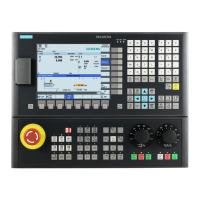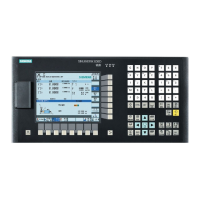K5: Mode groups, channels, axis interchange
5.3 Channels - only 840D sl
Extended Functions
Function Manual, 03/2013, 6FC5397-1BP40-3BA1
307
example
On large machine tools (machining centers), it may be necessary for a part program to be
processed on one part of the machine while new workpieces to be machined need to be
clamped and set up on another part. Such tasks usually require two independent NC
controls.
With the mode group function, both tasks can be implemented on one NC control with two
mode groups because a different mode can be set for each mode group (AUTOMATIC mode
for the program processing, JOG for setting up a workpiece).
Mode group assignment
The configuration of a mode group defines the channels, geometry axes, machine axes and
spindles which it is to contain.
A mode group consists of one or several channels which must not be assigned to any other
mode group. Machine axes, geometry axes and special axes themselves are assigned to
these channels. A machine axis can only be assigned to the channels of one mode group
and can only traverse in this mode group.
A mode group is configured with the following data:
● Channel-specific machine data:
MD10010 $MN_ASSIGN_CHAN_TO_MODE_GROUP (channel valid in mode group)
● Configuration data of the channels
Note
For more information about the first mode group, please refer to:
References:
Function Manual, Basic Functions; Mode Group, Channel, Program Operation Mode
(K1),
5.3 Channels - only 840D sl
Note
The terms Channel, Channel Configuration, Channel States, Effects of Commands/Signals,
etc. is described for the first channel in:
Reference:
Function Manual Basic Functions; Mode Group, Channel, Program Operation (K1)
For all other channels, this information applies, too.

